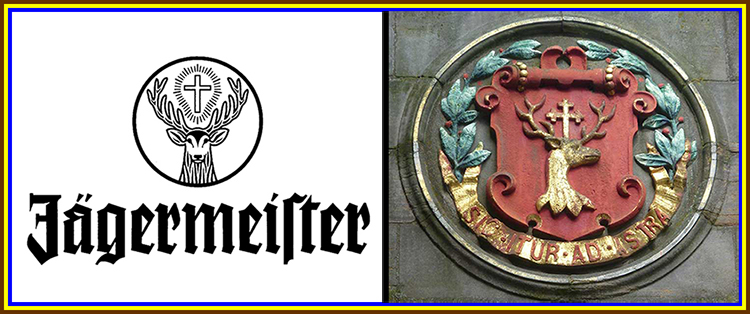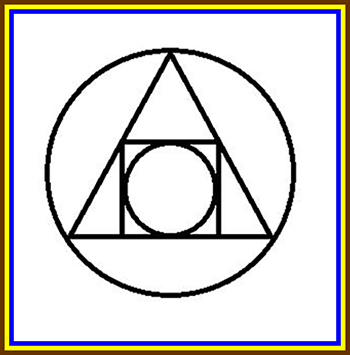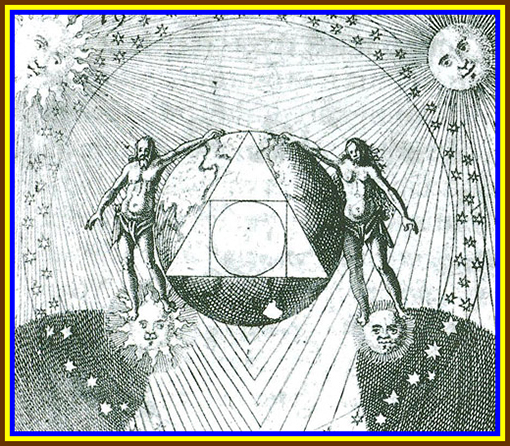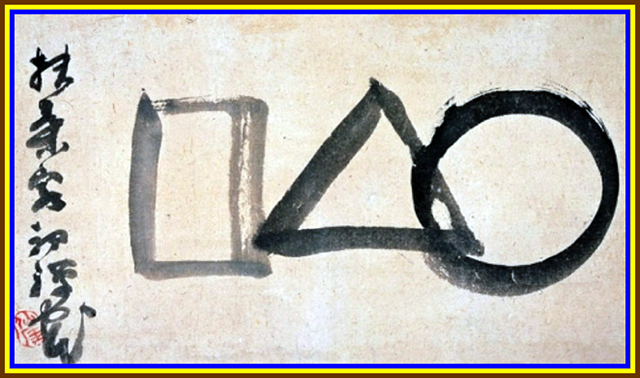

Things of Interest.
This page consists of objects that may be of interest to some of you and give food for thought.
Many of the symbols used in various orders are generally ignored or not fully understood
(I include myself in this sweeping generalisation), not many give them any real thought,
so hopefully this section will provoke you into giving our symbology some consideration.
![]()
The Jagermeister Logo and the coat of arms of the Canongate.
The name translates from the German for “master of hunters”, a job title given to a
What could be more fitting as a figurehead than the image of a mighty stag –
the epitome of pride and
Typography is a traditional Germanic, Gothic-styled typeface, which notably contains the ancient ‘Long S’ that is quite uncommon today.
What does the symbol circle-triangle-square mean, under which the Lectorium Rosicrucianum occurs?
The circle stands for the macrocosmic, unknowable Spirit of God, the fullness (the Pleroma),
Circle, triangle and square together at every level – whether the macrocosm, cosmos or microcosm – a universal symbol for the divine creation,
The Square, the Circle and the Triangle are also represented in Japanese culture.(click on link below).
Squaring of the Circle.
This figure represents the alchemical Squaring of the Circle, within the microcosm
The symbol is impeccable as a representation of alchemy, as it shows man's relationship
When one acquires the right knowledge and wisdom, they acquire an understanding,
These three symbols appear in Akido references as well.
Quote from a Student of Akido: "He rarely came down from Iwama. It was half a year O-Sensei often had me draw
a circle, triangle and a square

high-ranking hunting official for hundreds of years. Fittingly, the Jagermeister
logo consists of a stag’s head, whose antlers surround a glowing Christian cross
– symbolising two Christian patron saints of hunters, Saint Hubertus and Saint Eustace,
both of whom converted to Christianity after experiencing a vision in which they
saw a Christian cross between the antlers of a stag.
This image is also seen on the coat of arms of the Canongate.The coat of arms of the Canongate features
a white hart's head and a golden cross, recalling the old legend in which King David I was saved from
goring
from a stag by the sudden appearance of a holy cross.
uncompromising protection of the herd.
However, for the emblem of Jagermeister, it would not be just
any stag’s head
that came into question. Only a legendary stag’s head would do, one with a
beaming cross between its antlers. The stag that appeared to a wild hunter
and converted him to Christianity. The same hunter who later became the patron
saint of all hunters: Saint Hubertus.
This stag remains today, as it
always has been, the Jagermeister trademark.
A symbol of the preservation of their quality and tradition.![]()

from which all revelation evolves, and which embraces all creation.
From the circle, the triangle evolves, meaning the
divine spirit in its threefold revelation as Father, Son and Holy Spirit.
From the Holy Spirit evolves the
“square of the building”, the embodiment of the divine idea within the substance.
in its perfect manifestation of spirit (circle), soul (triangle) and body (square).
Thus, the sign of the unity of circle, triangle and square is also a symbol of the divine human being,who is to be revealed on the path of Rosycross.![]()
![]()

of the Work." D. Stolcius von Stolcenberg, Viridarium chymicum, Frankfurt, 1624.
Extract from "The Golden Game", Stanislas Klossowsky de Rola.
with the universe, the need to transcend the material (the square) towards the sublime
quality of the spiritual (the circle), all under the watchful protection of our maker (the triangle).
-a gnosis- that enables them to remove the shackles of the material world, achieve
oneness with spirit and then harmonize that oneness with the all.![]()

after I joined the dojo that I saw his face for the first time. Until then, I only
knew about him by hearsay. There weren’t any pictures of him like we have now.
When he smiled, his eyes disappeared. But when you just caught a glance of him,
the impression was really strong. When he looked at something for a second,
his face disappeared into his eyes. (Laughter) O-Sensei used to tell us a story.
We were really cheeky. For the most part, people did not approach O-Sensei…
Whenever I had a question I went up to O-Sensei and asked, “O-Sensei, there
was something I didn’t understand of what you said a little while ago.”
Sensei would say, “Oh, good you noticed that.”
and would say, “Keep it with you and bring it to me when I need it…"![]()